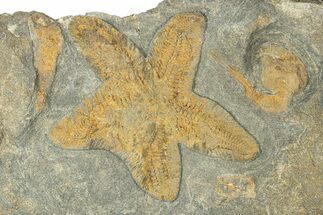This Specimen has been sold.
Two Ordovician Brittle Stars (Ophiura) With Edrioasteroids - Morocco
This plate features two fossil brittle stars (Ophiura sp.) from the Kataoua Formation of Morocco. They are Ordovician in age, or approximately 450 million years old. The largest brittle star is 3.4" wide. There are also a couple of Edrioasteroid fossils on the rock.
It comes with an acrylic display stand.
It comes with an acrylic display stand.
Edrioasteroids are an extinct class of echinoderms. Distantly related to starfish and sea urchins, they have a body laid out in a pentaradial (five-fold symmetry) pattern. They also had a water vascular system and a skeleton made of calcite plates. They were filter feeders who lived permanently attached to an object or the seafloor. Some are thought to have had short stems like crinoids, but most lived flat on whatever object they had attached to as larvae. Edrioasteroids appear in the Cambrian Period about 515 million years ago. Their diversity peaked during the Late Ordovician Period. By about 275 million years ago, during the Permian Period, edrioasteroids are extinct.
Edrioasteroids were small organisms from a few millimeters to a couple centimeters wide. They look like a tiny cushion attached to a substrate. The mouth was in the center of the theca (body) and from it, five ridges radiate out in a pentaradial pattern. These ambulacra channel food along the body to the mouth. There is little fossil evidence of how this was done, but by looking at modern echinoderms, it is likely Edrioasteroids had cilia or tube feet along the ambulacra that moved the food to the mouth. The ambulacra radiate out from the mouth in either straight lines, or curving to form a whorl. Usually they all curve in the same direction, but in a few species they curve in different directions.
Edrioasteroids were small organisms from a few millimeters to a couple centimeters wide. They look like a tiny cushion attached to a substrate. The mouth was in the center of the theca (body) and from it, five ridges radiate out in a pentaradial pattern. These ambulacra channel food along the body to the mouth. There is little fossil evidence of how this was done, but by looking at modern echinoderms, it is likely Edrioasteroids had cilia or tube feet along the ambulacra that moved the food to the mouth. The ambulacra radiate out from the mouth in either straight lines, or curving to form a whorl. Usually they all curve in the same direction, but in a few species they curve in different directions.
SPECIES
Ophiura sp.
AGE
LOCATION
Kaid rami, Morocco
FORMATION
Kataoua Formation
SIZE
Largest brittle star: 3.4" wide, Rock: 6.4 x 6.3"
CATEGORY
SUB CATEGORY
ITEM
#271438
We guarantee the authenticity of all of our specimens.
 Reviews
Reviews











